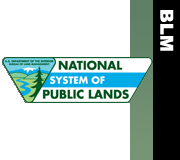|
Print Page | |||||||||||||||||||||||||||||||||||||||||||||||||||||||||||||
Mining Law - Surface Management
To implement reclamation for locatable mining activities on BLM administered lands, the 43 CFR 3809 regulations apply. These regulations address three levels of surface disturbing activities: (1) for casual use where mechanized equipment and explosives are not used, there is no requirement to contact the BLM; (2) if proposed exploration would cause a surface disturbance of five acres or less per year, the operator is required to submit a notice to BLM 15 days before starting work; and (3) a plan of operation must be submitted to BLM if the surface activity is more than casual use. The plan of operation must contain a detailed description of the proposed mining and reclamation activities. All operations, whether casual, under a notice, or under a plan of operation must be reclaimed. Gold production on California federal lands decreased by 1% from 560,000 ounces in 1999 to 553,000 ounces in 2000. The Mesquite Mine in Imperial County was the state´s production leader with 130,000 ounces, a reduction from 164,000 ounces the previous year. The mine operator has proposed expanding mining operations because the mine will be depleted of ore reserves by 2001. An EIS for the proposed expansion was released in 2000 and a decision is expected in 2001. Other top gold mine producers were the Castle Mountain Mine, 119,000 ounces in San Bernardino County, and the McLaughlin Mine, 108,000 ounces in Napa County. The revised 43 CFR 3809 regulations became effective on January 20, 2001. Some of the major changes are: the elimination of the five acres threshold for plans of operations, all mining beyond "casual use" will require a plan, and financial bonding is required for any disturbance greater than "casual use." Notices are required for exploration proposals on less than five acres. For the first time, BLM can reject a mining proposal if the proposal will cause "substantial irreparable harm to significant scientific, cultural, or environmental resource values of the public lands that cannot be effectively mitigated." BLM continues to work in partnership with the U.S. Forest Service, U.S. Geological Survey, and the State Conservation Division to study and cleanup lands that were damaged by abandoned mines in the Bear/Yuba watersheds. Water studies for mercury contamination in the Trinity Watershed were initiated during 2000, and continue during this year. Surface Management Statistics - FY 2000
Gold Production from BLM Administered
Closed Mines
Permitted, Not Opened Not Permitted
|
||||||||||||||||||||||||||||||||||||||||||||||||||||||||||||||







